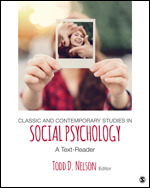Classic and Contemporary Studies in Social Psychology
A Text-Reader
Edited by:
- Todd D. Nelson - California State University, Stanislaus
Other Titles in:
Social Psychology (General)
Social Psychology (General)
April 2018 | 440 pages | SAGE Publications, Inc
Classic and Contemporary Studies in Social Psychology is a combined text and reader that presents social psychology firsthand through the influential studies that have shaped the field. Each topic includes annotated readings to demystify the research design process and help students understand how theory connects to experimental design in social psychology. To prepare readers for concepts within each original journal article, Todd D. Nelson discusses pivotal themes, ideas, and methods in introductory sections that precede the reading. Following each article, Nelson reinforces key topics and links the article to related concepts within the field.
1 History of Social Psychology
Norman Triplett
Richard T. LaPiere
2 Research Methods
Elliot Aronson, Phoebe C. Ellsworth, J. Merrill Carlsmith, and Marti Hope Gonzales
Chris Ann Dickerson, Ruth Thibodeau, Elliot Aronson, and Dayna Miller
3 Social Cognition
Birte Englich, Thomas Mussweiler, and Fritz Strack
Victoria Husted Medvec, Scott F. Madey, and Thomas Gilovich
4 The Self
Dana R. Carney, Amy J. C. Cuddy, and Andy J. Yap
Andy J. Yap, Abbie S. Wazlawek, Brian J. Lucas, Amy J. C. Cuddy, and Dana R. Carney
5 Attitudes
Leon Festinger and James M. Carlsmith
S. Christian Wheeler, Pablo Briñol, and Anthony D. Hermann
6 Social Perception
Robert E. Kleck and Angelo Strenta
Janine Willis and Alexander Todorov
7 Attribution
Norbert Schwarz and Gerald L. Clore
Piotr Winkielman, Norbert Schwarz, and Robert F. Belli
8 Social Influence
Stanley Milgram
Ellen Langer, Arthur Blank, and Benzion Chanowitz
9 Prejudice
Patricia G. Devine
Galen V. Bodenhausen
10 Prosocial Behavior
John M. Darley and Bibb Latané
John M. Darley and C. Daniel Batson
11 Aggression
Brad J. Bushman and Craig A. Anderson
Dov Cohen and Richard E. Nisbett
12 Groups
Robert B. Zajonc, Alexander Heingartner, and Edward M. Herman
Richard Ronay, Katharine Greenaway, Eric M. Anicich, Adam D. Galinsky
References
